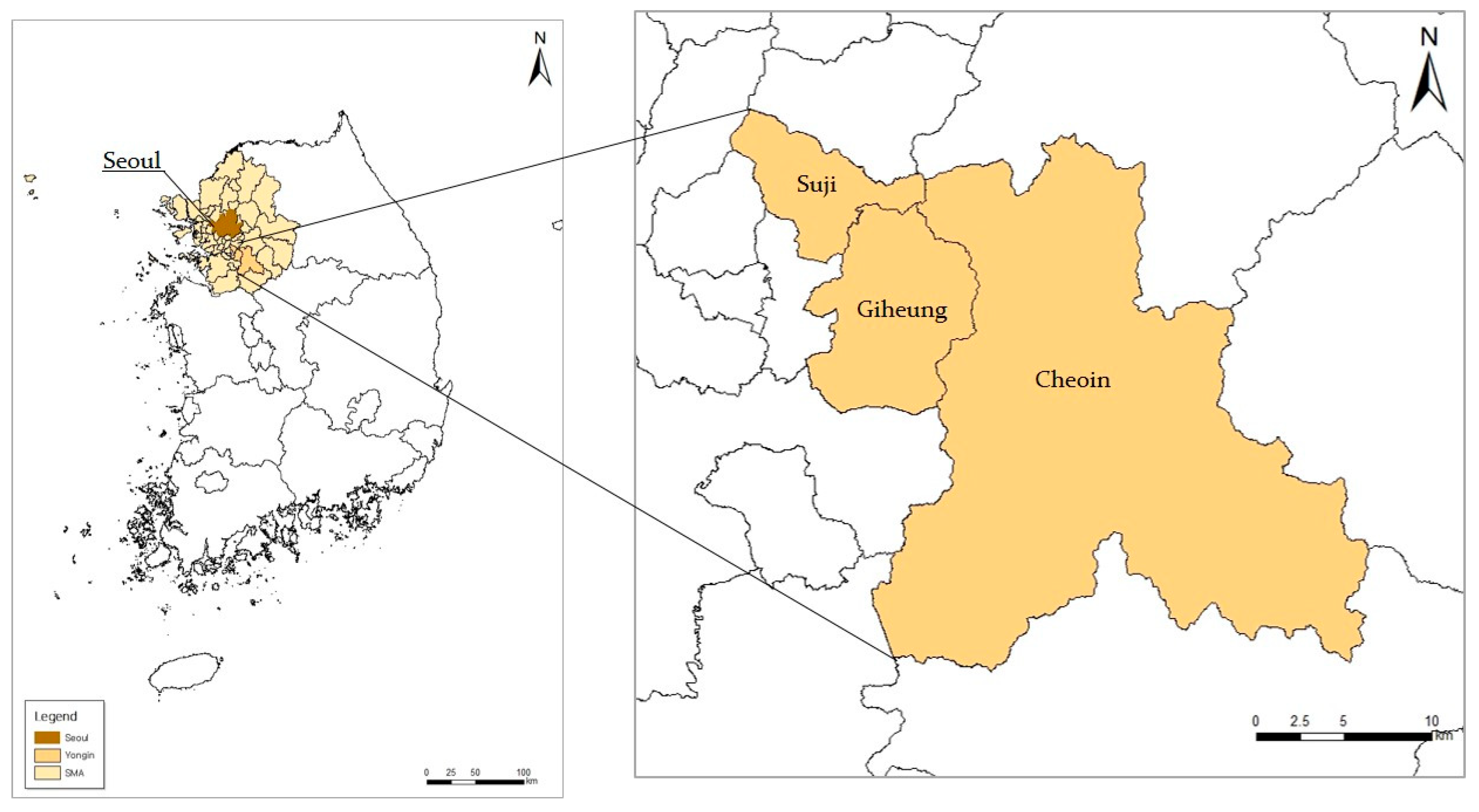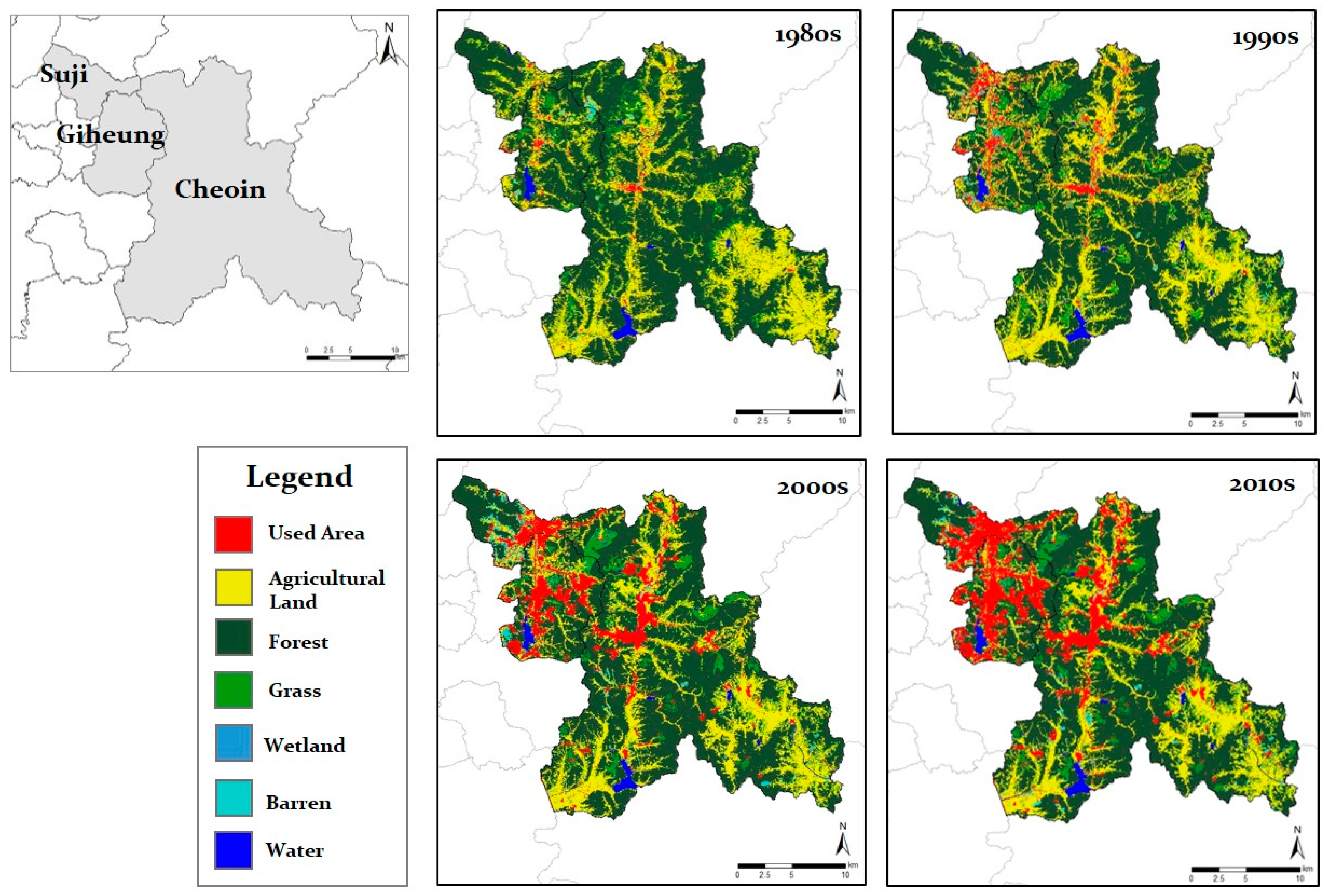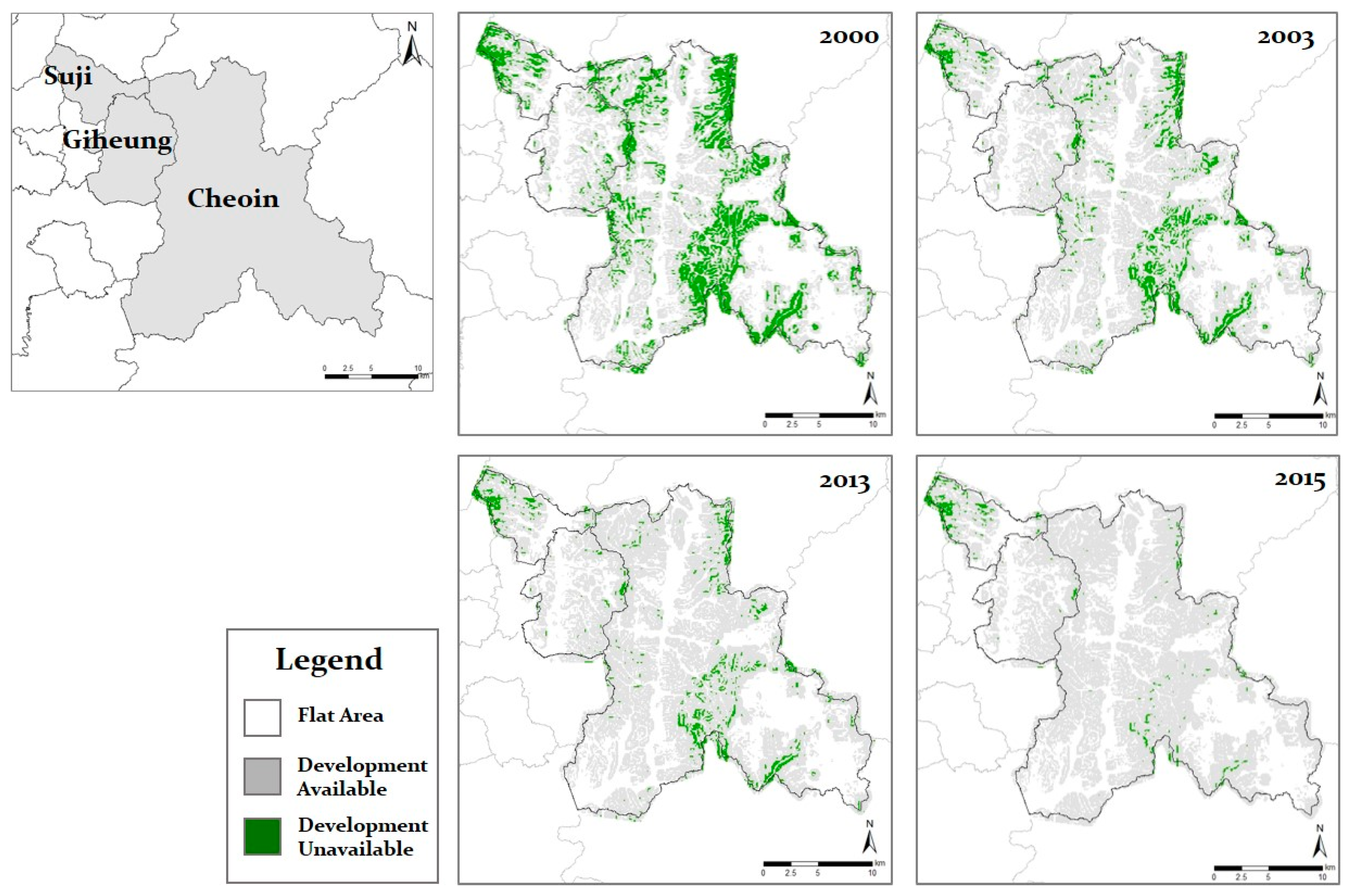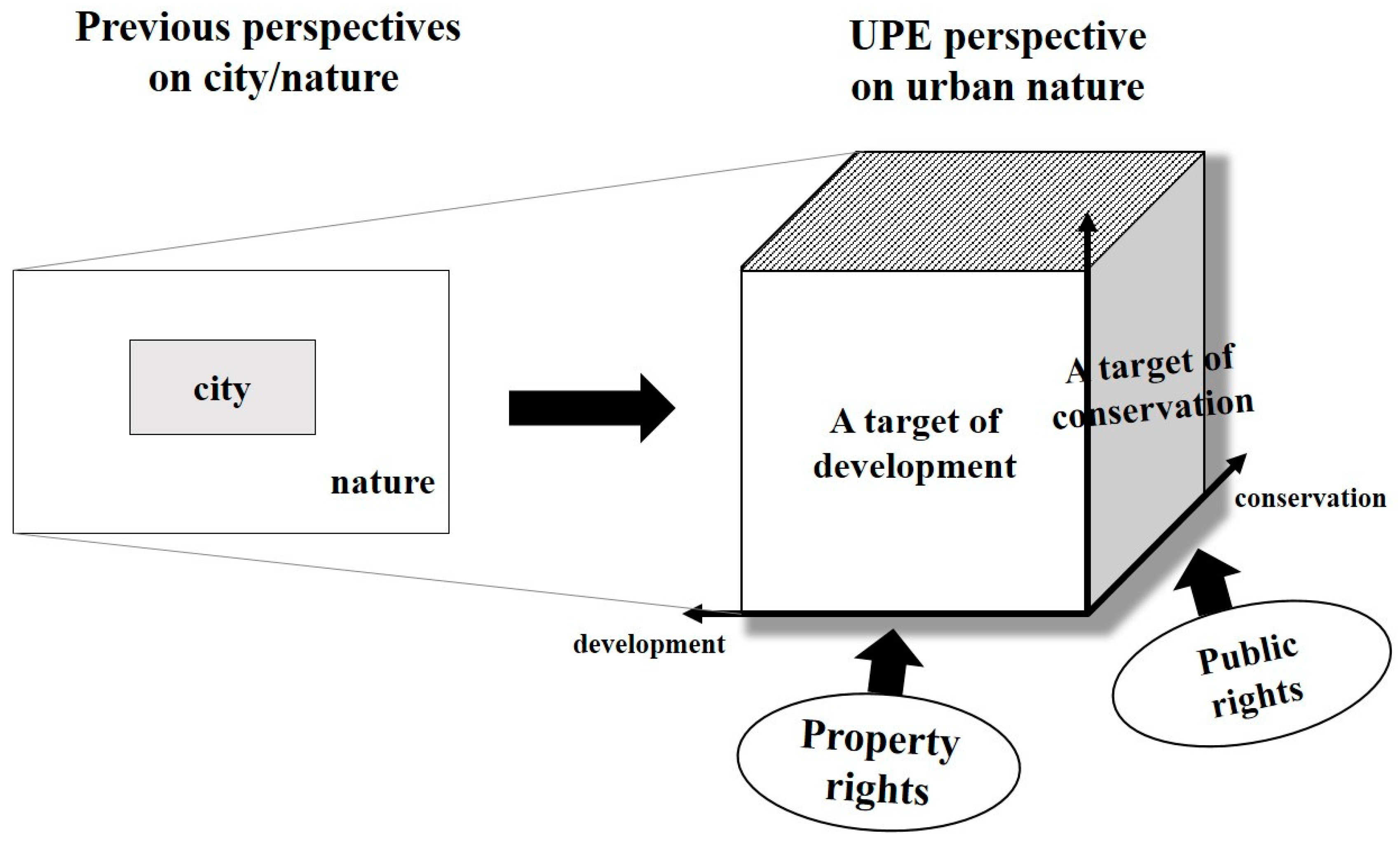Slope Matters: Anti-Sprawl and Construction of Urban Nature in Yongin, South Korea
Abstract
:1. Introduction
1.1. Yongin: The Epitome of Urban Sprawl in South Korea
1.2. Urban Sprawl and the Recent ‘Environmental Turn’
1.3. Research Method
2. Literature Review
2.1. Urban Nature and the Context of Space
2.2. New Actors Creating Urban Nature
3. Case Study and Analysis
3.1. The Slope Ordinance and Uneven Development in the City
3.2. The Four Amendments to the Slope Ordinance
4. Discussion
4.1. Link between Development and Conservation
4.1.1. Development as a Way to Narrow the Gap
I [city councillor] met the landowners today. It may be better not to destroy forest for development. But where are their [anti-sprawl advocates’] apartments located? They were built on the destroyed forest too. But, now they just want to keep the forest untouched for a better view from their living room? Let’s be fair. Everyone can make a complaint, but let’s do it in accordance with reality.(76th City Council Meeting, May 2003)
Suji and Giheung are talking about environmental conservation these days. The question is, is it fair for them to prevent us from deforesting for development after they have already ruined it to build apartment complexes?(City councillor of Cheoin, August 2020)
4.1.2. Time to Protect the Environment?
Since Yongin has already been significantly developed, I want it [the strengthened slope ordinance] to prevent further destroying of the forest and development at least symbolically. Also, there are still a few vulnerable places that can be developed. We [city councillor of Suji and Giheung] are afraid there might be huge complaints from nearby large apartment complexes when those places would be developed.(City councillor of Giheung, August 2020)
4.2. New Agents in Urban Politics
4.2.1. Residents’ Desire to Enjoy Green Landscapes
In 2011, the small hiking trail disappeared. It was an ecological playfield for the education of children as well as for daily exercise, but it just disappeared. I knocked on every door in the apartment complex and received consent from 90% of the residents to stop the development and delivered their opinions and signatures to the city’s administration. I guess that’s how it started.(Citizen activist, September 2020)
4.2.2. The Environmental Turn
5. Conclusions
Author Contributions
Funding
Institutional Review Board Statement
Informed Consent Statement
Data Availability Statement
Conflicts of Interest
References
- KOSIS (Korea Statistical Information Service). Available online: https://url.kr/3dstqh (accessed on 30 August 2021).
- Heynen, N. Urban political ecology I: The urban century. Prog. Hum. Geogr. 2014, 38, 598–604. [Google Scholar] [CrossRef]
- Hong, S. Study on the Provision of Infrastructures in the Unsustainable Development Area of the Capital Region—The Case of Northwest Area of Yongin City. Master’s Thesis, Gacheon University, Seongnam, Korea, 2000. [Google Scholar]
- Lee, J.; Shim, J. Articles: A measurement of the spatial structural change by the urban growth: A case of Yongin-Si. Korean Urban Geogr. Soc. 2006, 9, 15–29. [Google Scholar]
- Shin, S. Political Economy of Urban Growth and Development: Case Study of Urban Sprawl in Yongin City. Ph.D. Thesis, Korea University, Seoul, Korea, 2004. [Google Scholar]
- Special Committee on the Investigation of Unplanned Development (SCIUD). White Paper of Yongin’s Special Committee on the Investigation of Unplanned Development 2019; Special Committee on the Investigation of Unplanned Development (SCIUD): Yongin, Korea, 2019. [Google Scholar]
- Swyngedouw, E. The city as a hybrid: On nature, society and cyborg urbanization. Capital. Nat. Soc. 1996, 7, 65–80. [Google Scholar] [CrossRef]
- Cornea, N.L.; Véron, R.; Zimmer, A. Everyday governance and urban environments: Towards a more interdisciplinary urban political ecology. Geogr. Compass 2017, 11, e12310. [Google Scholar] [CrossRef]
- Gandy, M. Urban nature and the ecological imaginary. In In the Nature of Cities; Routledge: New York, NY, USA, 2006; pp. 78–89. [Google Scholar]
- Kitchen, L. Are trees always ‘good’? Urban political ecology and environmental justice in the valleys of South Wales. Int. J. Urban Reg. Res. 2013, 37, 1968–1983. [Google Scholar] [CrossRef]
- McCarthy, J. Devolution in the woods: Community forestry as hybrid neoliberalism. Environ. Plan. A 2005, 37, 995–1014. [Google Scholar] [CrossRef]
- Tubridy, D. Green climate change adaptation and the politics of designing ecological infrastructures. Geoforum 2020, 113, 133–145. [Google Scholar] [CrossRef]
- Heynen, N.; Kaika, M.; Swyngedouw, E. (Eds.) Urban political ecology and the politics of urban metabolism. In In the Nature of Cities; Routledge: New York, NY, USA, 2006; pp. 1–20. [Google Scholar]
- Swyngedouw, E.; Kaika, M.; Bridge, G.; Watson, S. The Environment of the City or…. The Urbanisation of Nature. In Reader in Urban Studies; Blackwell: Oxford, UK, 2000. [Google Scholar]
- Brownlow, A. Inherited fragmentations and narratives of environmental control in entrepreneurial Philadelphia. In In the Nature of Cities; Routledge: New York, NY, USA, 2006; pp. 208–225. [Google Scholar]
- Robbins, P.; Sharp, J.T. Producing and consuming chemicals: The moral economy of the American lawn. Econ. Geogr. 2003, 79, 425–451. [Google Scholar] [CrossRef]
- Lawhon, M.; Ernstson, H.; Silver, J. Provincializing urban political ecology: Towards a situated UPE through African urbanism. Antipode 2014, 46, 497–516. [Google Scholar] [CrossRef] [Green Version]
- Gabriel, N. Paradox and possibility: Voluntarism and the urban environment in a post-political era. Soc. Cult. Geogr. 2020, 21, 143–161. [Google Scholar] [CrossRef]
- Ilcan, S. Privatizing responsibility: Public sector reform under neoliberal government. Can. Rev. Sociol./Rev. Can. De Sociol. 2009, 46, 207–234. [Google Scholar] [CrossRef] [PubMed]
- Swyngedouw, E. Depoliticized environments: The end of nature, climate change and the post-political condition. R. Inst. Philos. Suppl. 2011, 69, 253–274. [Google Scholar] [CrossRef]
- Cidell, J. Cooperating on Urban Sustainability: A Social Network Analysis of Municipalities across Greater Melbourne. Urban Policy Res. 2020, 38, 150–172. [Google Scholar] [CrossRef]
- Narain, V. Growing city, shrinking hinterland, transition and conflict in peri-urban Gurgaon, India. Environ. Urban. 2009, 21, 501–512. [Google Scholar] [CrossRef]
- Goldfischer, E.; Rice, J.L.; Black, S.T. Obstinate curiosity and situated solidarity in urban political ecology. Geogr. Compass 2020, 14, e12479. [Google Scholar] [CrossRef]
- Loh, P.; Agyeman, J. Urban food sharing and the emerging Boston food solidarity economy. Geoforum 2019, 99, 213–222. [Google Scholar] [CrossRef]
- Keil, R.; Boudreau, J.A. Metropolitics and metabolics: Rolling out environmentalism in Toronto. In In the Nature of Cities; Routledge: New York, NY, USA, 2006; pp. 56–77. [Google Scholar]
- Logan, J.R.; Molotch, H. Urban Fortunes: The Political Economy of Place, with a New Preface; University of California Press: Berkeley, CA, USA, 2007. [Google Scholar]
- Ryu, J.; Chi, S. Politics of urban sprawl, a case of urban planning ordinance amendments in Yongin. J. Korean Geogr. Soc. 2021, 56, 149–160. [Google Scholar]




| Year | Yongin | ||
|---|---|---|---|
| Suji | Giheung | Cheoin | |
| 2000 | 14 | 14 | 14 |
| 2003 | 17.5 | 17.5 | 17.5 |
| 2013 | 17.5 | 17.5 | 20 |
| 2015 | 17.5 | 21 | 25 |
| 2019 | 17.5 | 17.5 | 20 |
| Mountain Areas (km2) | Available for Development | Not Available for Development | |||
|---|---|---|---|---|---|
| Area (km2) | Proportion (%) | Area (km2) | Proportion (%) | ||
| Yongin | 328.7 | 322.1 | 98.0 | 6.6 | 2.0 |
| Suji | 271.3 | 269.4 | 99.3 | 2.0 | 0.7 |
| Giheung | 33.5 | 33.1 | 98.8 | 0.4 | 1.2 |
| Cheoin | 23.9 | 19.7 | 82.3 | 4.2 | 17.7 |
Publisher’s Note: MDPI stays neutral with regard to jurisdictional claims in published maps and institutional affiliations. |
© 2021 by the authors. Licensee MDPI, Basel, Switzerland. This article is an open access article distributed under the terms and conditions of the Creative Commons Attribution (CC BY) license (https://creativecommons.org/licenses/by/4.0/).
Share and Cite
Ryu, J.; Chi, S.-H. Slope Matters: Anti-Sprawl and Construction of Urban Nature in Yongin, South Korea. Sustainability 2021, 13, 12401. https://doi.org/10.3390/su132212401
Ryu J, Chi S-H. Slope Matters: Anti-Sprawl and Construction of Urban Nature in Yongin, South Korea. Sustainability. 2021; 13(22):12401. https://doi.org/10.3390/su132212401
Chicago/Turabian StyleRyu, Jewon, and Sang-Hyun Chi. 2021. "Slope Matters: Anti-Sprawl and Construction of Urban Nature in Yongin, South Korea" Sustainability 13, no. 22: 12401. https://doi.org/10.3390/su132212401
APA StyleRyu, J., & Chi, S.-H. (2021). Slope Matters: Anti-Sprawl and Construction of Urban Nature in Yongin, South Korea. Sustainability, 13(22), 12401. https://doi.org/10.3390/su132212401






